Spotlight: China's efforts in post-earthquake reconstruction exemplary

Combination photo taken on May 14, 2008 (left) and May 6, 2015 shows a sharp contrast of an aerial view of Wenchuan County, which was hit by an 8.0-magnitude earthquake on May 12, 2008, southwest China's Sichuan Province. (Xinhua/Chen Kai, Luo Guoyang)
As one of the countries which suffers most from natural disasters, China has improved greatly its ability to deal with natural disasters and post-disaster reconstruction.
Having witnessed two of the gravest earthquakes in China over the last decade, China's southwestern Sichuan Province has now successfully rebuilt towns shattered by natural catastrophes and provided disaster survivors with better homes.
More than seven years ago, a deadly earthquake of magnitude 8.0 hit Wenchuan, a county in Sichuan Province, which ruptured about 300 kilometers of the Longmenshan Fault Zone in the vast land of the province and killed more than 80,000 people.

Combination photo taken on May 14, 2008 (left) and May 6, 2015 shows a sharp contrast of an aerial view of Wenchuan County. (Xinhua/Chen Kai, Luo Guoyang)
The quake, which occurred on May 12, 2008 and has been the most destructive earthquake with the greatest impact since the founding of the People's Republic of China in 1949, destroyed more than 120 million square meters of houses and rendered over 15 million people homeless.
In a quick response, the Chinese central government on the first day dispatched rescue teams, medical workers and thousands of soldiers to the quake-struck areas.
On the 11th day after the Wenchuan earthquake, an unprecedented reconstruction mission in China's history was unveiled as the central government initiated reconstruction plans, with a goal of rebuilding new homes for the survivors in three years.
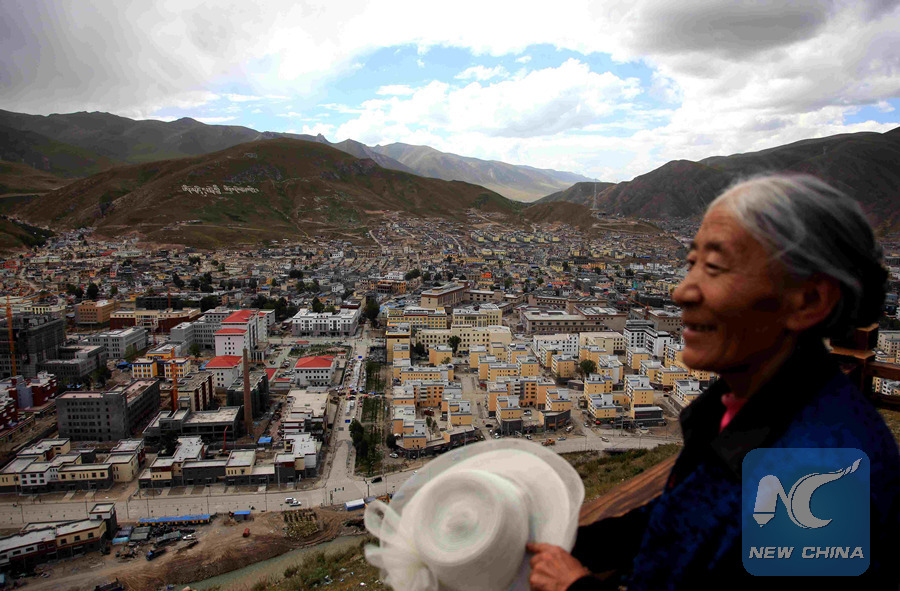
A woman gets a bird's-eye view of Yushu Tibet Autonomous Prefecture, on the Dangdai Mountain, northwest China's Qinghai Province, Aug. 30, 2013. Reconstruction work was underway in Yushu Tibet Autonomous Prefecture, where a strong earthquake occurred on April 14, 2010. (Xinhua/Jia Haiyuan)
In order to mobilize nationwide resources as quick as possible, the government ordered 19 provinces in the more economically developed eastern and central China areas to provide one-on-one assistance to each county in the disaster areas in Sichuan province.
In three years, the Chinese government appropriated more than 300 billion yuan (about 48.3 billion U.S. dollars) to fund various reconstruction projects in the area. More than 100 towns re-emerged from the ruins of the disaster, with about 6.6 million new houses built for the survivors.
After the Wenchuan quake, China updated its mechanism of responding to major earthquakes and of after-quake reconstruction, which made rescue and reconstruction efforts in the 2013 Lushan earthquake more effective and efficient.

People work at the construction site of an ethnic middle school in Yushu Tibetan Autonomous Prefecture on Aug. 9, 2011. (Xinhua/Wu Guangyu)
Pan Yunliang, a professor with the Central Party School of the Communist Party of China, said it is a major innovation in China's post-disaster reconstruction mechanism to shift post-disaster reconstruction efforts from operations directly commanded by the central government to the responsibility of local governments.
Such a change can boost the local governments' ability to deal with natural disasters, and make the reconstruction projects more suitable to the needs of local dwellers, said Pan.
Scientific planning makes new homes safer and more suitable for living. For instance, more than 1,600 geological disasters were recorded in Lushan county last year, but no major casualty was reported.
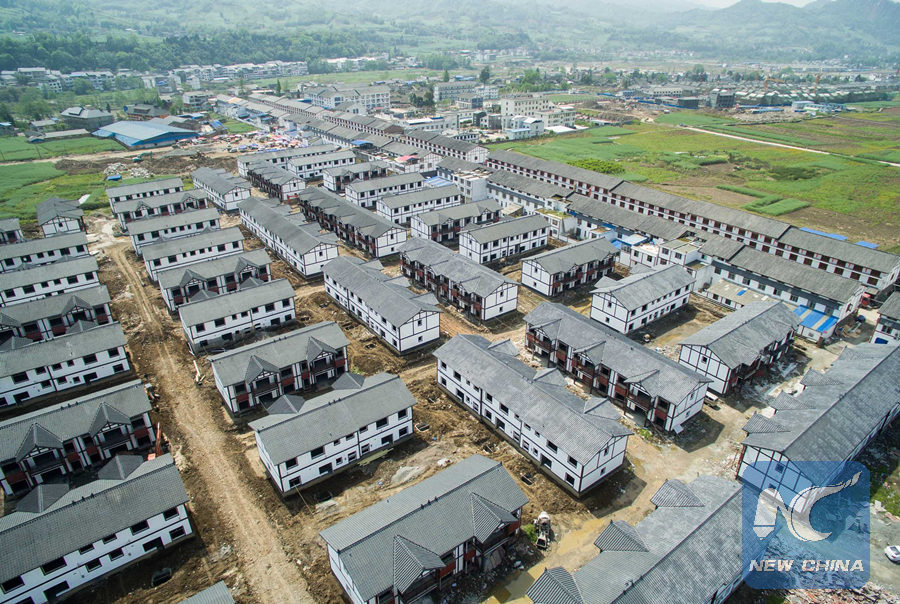
An aerial view of Fujiaying New Village of Qinglongchang Village of Longmen Township in Lushan County, southwest China's Sichuan Province, is seen in this picture taken on April 12, 2015, ahead of the two anniversary of the 7.0-magnitude earthquake hitting Lushan County on April 20, 2013. (Xinhua/Li Qiaoqiao)
Moreover, in the rebuilding projects of Wenchuan and Lushan, schools, hospitals and houses were given top priority.
Three years after the Wenchuan earthquake, China has built about 3,000 schools and more than 1,100 medical facilities to offer better public services.
Two years after the Lushan earthquake, all the houses in the rural areas have been rebuilt, while more than 40 percent of the urban housing reconstruction has been completed.
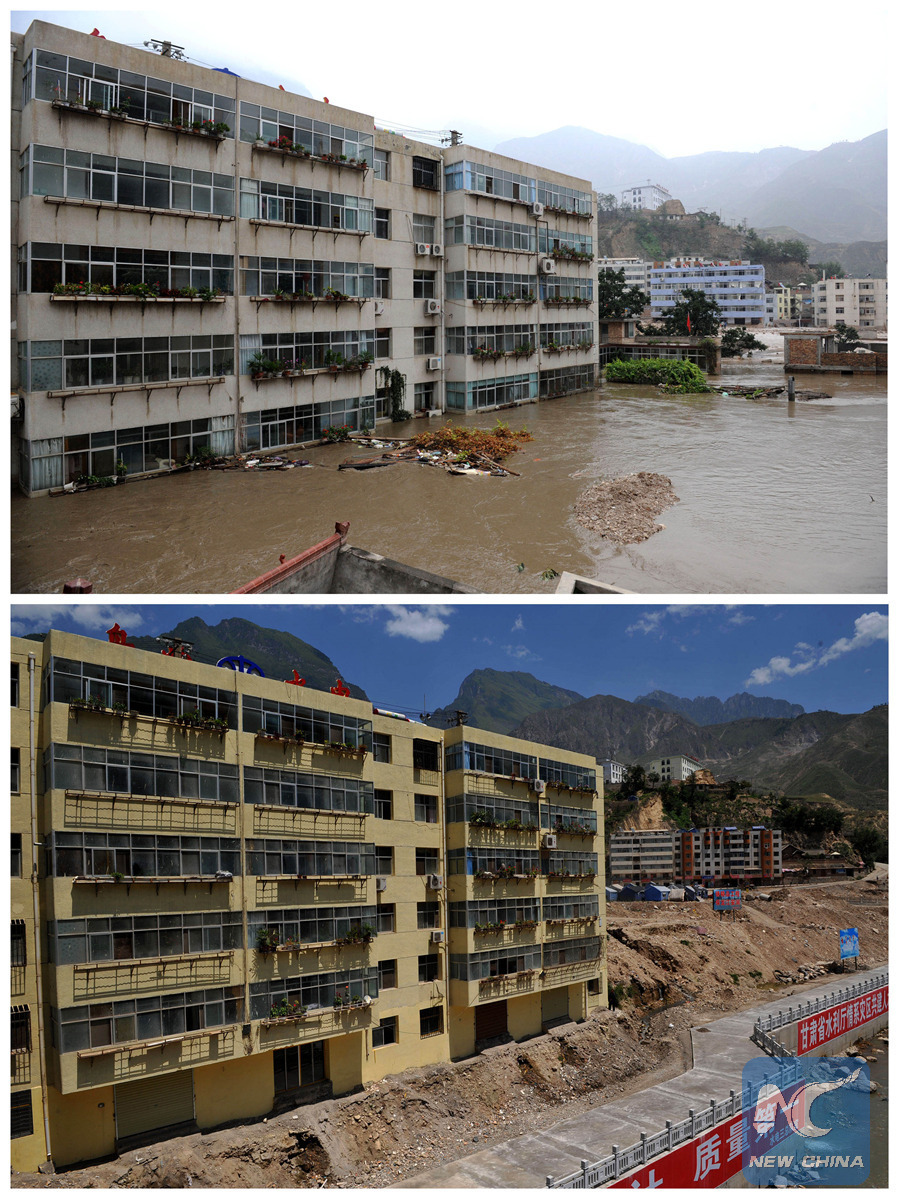
The combined photo shows a scene in Zhouqu County, northwest China's Gansu Province, on Aug. 12, 2010 (upper) and on Aug. 7, 2011. The mudslide devastation in the county on Aug. 8, 2010 left more than 1,700 people dead or missing and some 60,000 houses damaged. (Xinhua/Liu Xiao)
Setting "People First" as the basic principle in rebuilding Wenchuan and Lushan, the Chinese government has given special attention to poor families and made the alleviation of their suffering a focus in implementing the entire reconstruction program.
In the process of rebuilding Lushan county, the government of Sichuan Province has provided free new houses for 625 poor families.
And it has also called on government officials and party members to make point-to-point assistance for 4,400 hardest-hit families that need extra help in their post-disaster reconstruction efforts.
Editor: Lucia Su
Your Comment
Name E-mailRelated News
-
;
-
-
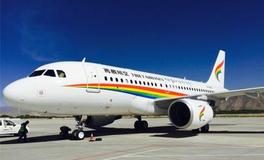
-
Tibet sees record number of air passengers in 2015
Tibet Autonomous Region in southwest China saw a record 3.63 million air passengers in 2015, up 15.2 percent from the previous year, regional civil aviation statistics show.
-
-
-
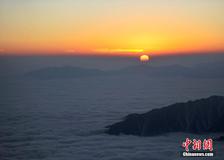
-
Tourism revenue in Tibet's Lhasa to double by 2020
Tourism revenue in Lhasa, capital of China's Tibet Autonomous Region, will double in the next five years, accounting for over 40 percent of local econ
-
Based in Lhasa, Tibet Vista is a Tibet travel agency that specialized in Tibet permit, and Tibet tours for both private and group travelers at a local price!
•4 Days Lhasa City Group Tour from USD 460 •8 Days Everest Base Camp Group Tour from USD 850 •15 Days Mt.Kailash Group Tour from USD 1780 •2016 Tibet Train Tours from Beijing, Shanghai, Chengdu, Xining,etc










